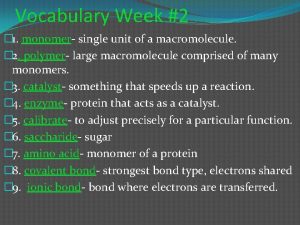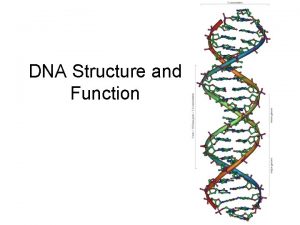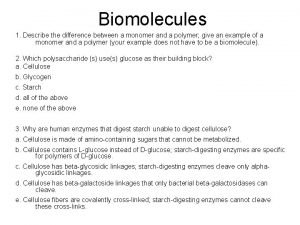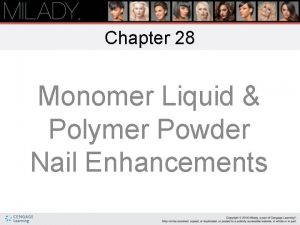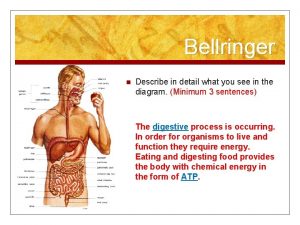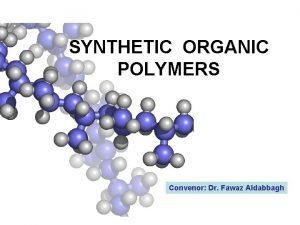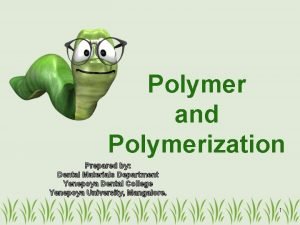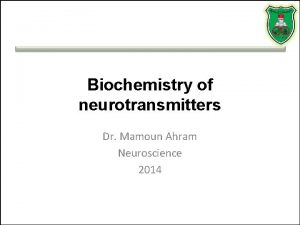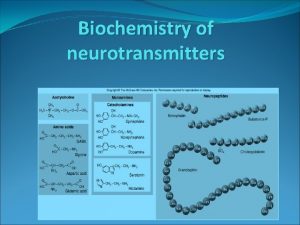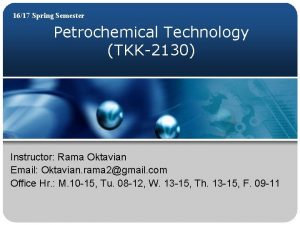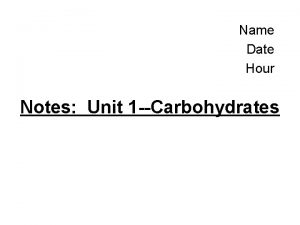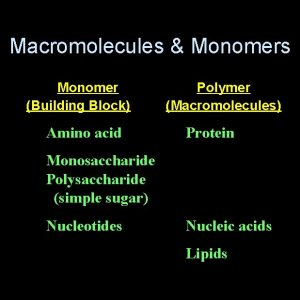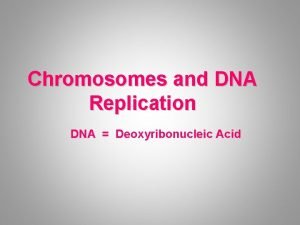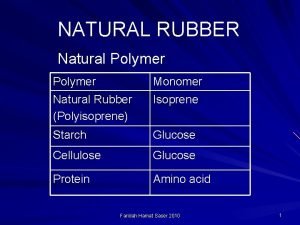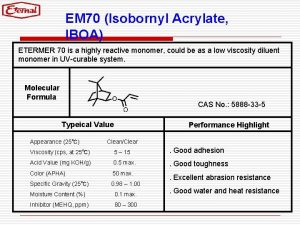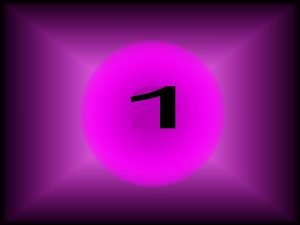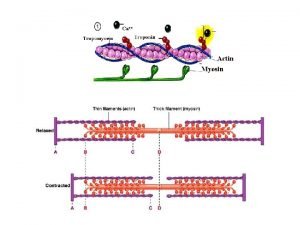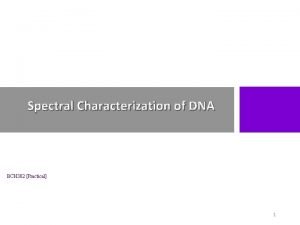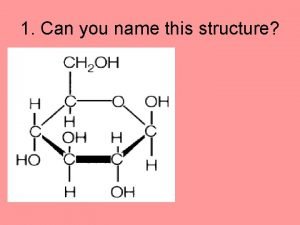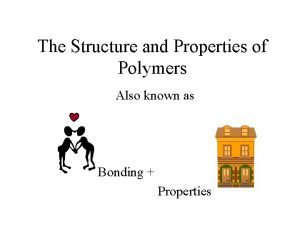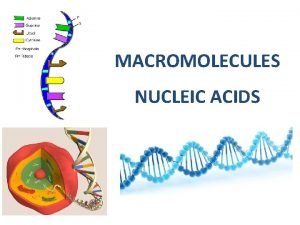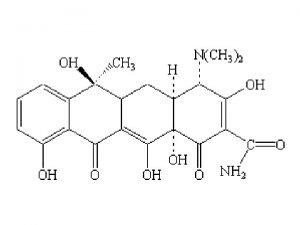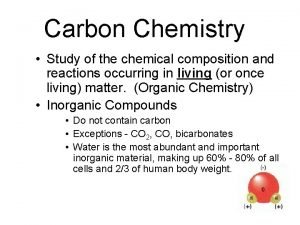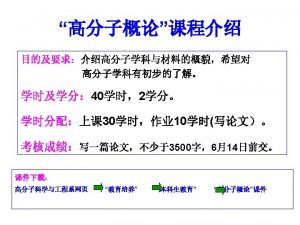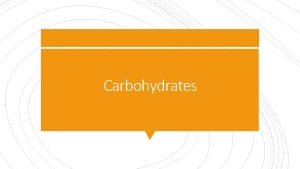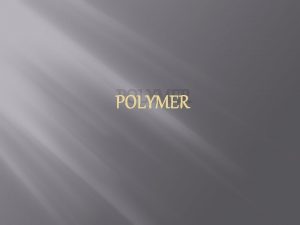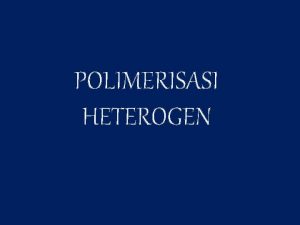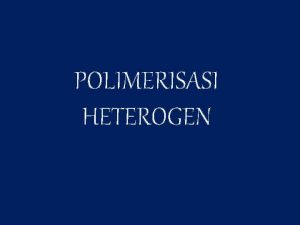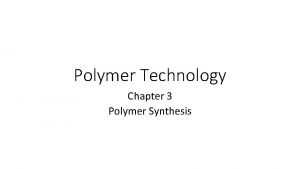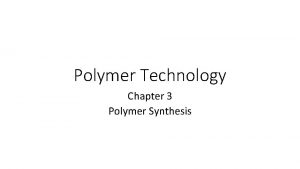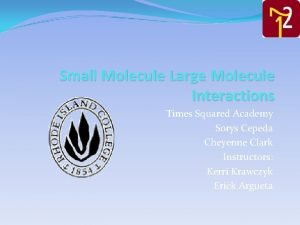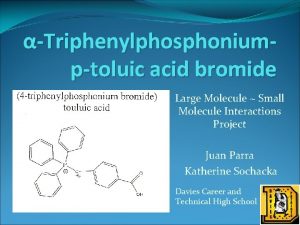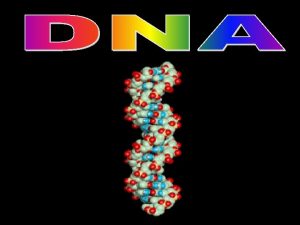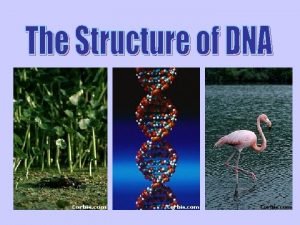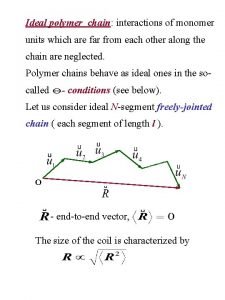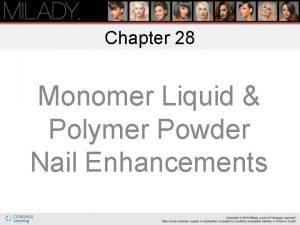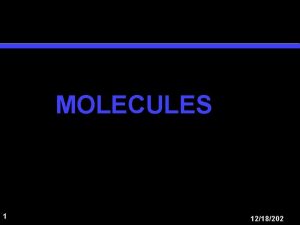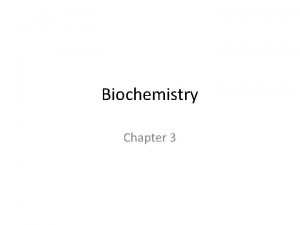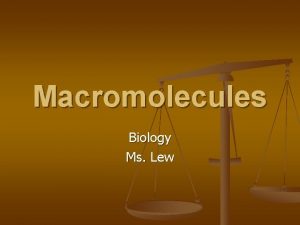Monomer is a small molecule Polymer is a


























- Slides: 26

Monomer is a small molecule Polymer is a long chain of monomers The process by which monomers combine is called polymerization

Hermann Staudinger (1881 – 1965) “Father of Macromolecular Chemistry” 1953 Nobel Prize in Chemistry. ØGerman chemist who demonstrated the existence of macromolecules, which he characterized as polymers. ØHe postulated that materials such as natural rubber have very high molecular weights. In a paper, Staudinger presented several reactions that form high molecular weight molecules by linking together a large number of small molecules. During this reaction, which he called "polymerization, " individual repeating units are joined together by covalent bonds.

Repeating units are a simplified method of drawing a polymer Polymers consist of repeating molecular units which usually are joined by covalent bonds

A pendant group on a polymer is a small group of atoms (even a small chain sometimes) that hangs off of the main chain (that is, the backbone of the polymer). Here are some examples of pendant groups circled in red: polypropylene polyvinylalcohol polystyrene

Polymers can be classified into several ways: • Based on Structure of Polymers i) Linear polymers (ii) Branched chain polymers (iii) Cross linked polymers • Based on the Origin of the Polymer i) Natural polymers (ii) Semi-synthetic polymers (iii) Synthetic polymers • Based on Types of Monomers i) Homopolymer (ii) Copolymer • Based on Tacticity (Configuration) i) Isotactic polymer (ii) Syndiotactic polymer (iii) Atactic polymer • Based on Synthesis i) Addition polymers (ii) Condensation polymers • Based on Thermal Processing Behaviour i) Thermoplastic Polymers (ii) Thermosetting Polymer

Classification Based on Structure of Polymers

Linear Polymers: Appearance of real linear polymer chains as recorded using an atomic force microscope on surface under liquid medium. Chain contour length for this polymer is ~204 nm; thickness is ~0. 4 nm. (The contour length of a polymer chain is its length at maximum physically possible extension).

Linear Polymer: Branched Polymer:

Linear Polymer: Cross-linked Polymer:

Star Polymer:

Dendrimers:

Classification Based on the Origin of the Polymer • Natural • Semi-synthetic • Synthetic

Natural Polymers: Polymers in Plants Cellulose, a linear polymer of D-glucose units (two are shown) linked by β(1→ 4)-glycosidic bonds.

While cellulose is a basic structural material of most plant substances, it is also produced by bacteria. Bacterial cellulose has different properties from plant cellulose and is characterized by high purity, strength, moldability and increased water holding ability. In natural habitats, the majority of bacteria synthesize cellulose, which form protective envelopes around the cells. Many methods are currently being investigated to enhance cellulose growth from cultures in laboratories as a large-scale process. A purified microbial cellulose sample Paper made from bacterial cellulose

Starch

Natural Rubber Natural rubber is a polymer of isoprene Charles GOODYEAR discovered vulcanization in 1839

Natural Polymers: Polymers in Animals Protein

Examples of Proteins All enzymes are proteins. Collagen in teehth and bone; keratin in skin, hair and nails.

Chitin the exoskeletons of crabs, lobsters and shrimps (polymer of the N-Acetylglucosamine units)

Semi-synthetic Polymers: Cellulose nitrate and cellulose acetate obtained from natural polymers by subjecting them to some chemical processes Cellulose nitrate Cellulose triacetate

Synthetic Polymers 1950 s Black Bakelite Telephone Bakelite Sockets & Switches Bakelite (1909) Blue Bakelite Handle

Poly(methyl methacrylate) (PMMA) (1935) PMMA sheet (organic glass) Plexiglass aquarium

Polystyrene (1937) Styrofoam - a brand of polystyrene foam rigid polystyrene case, weight 2. 6 Kg

Nylon 6, 6 (1938) A 1949 advertisement in Life Magazine sings the praises of nylon products. Natural animal bristles were replaced by synthetic fibers, usually nylon, by Du. Pont in 1938.

Polyesters (1950) Recycled PET Fabric Poly(ethylene terephthalate)-PET bottles

Polycarbonates (1957) GE Lexan® face shield Lexan MR-10 windshields
 Monomer polymer vocabulary ws
Monomer polymer vocabulary ws Polymer structure of nucleic acids
Polymer structure of nucleic acids Glycogen vs starch vs cellulose
Glycogen vs starch vs cellulose During removal monomer liquid
During removal monomer liquid Monomer-polymer matchup
Monomer-polymer matchup Polymerization of monomers
Polymerization of monomers Monomer liquid and polymer powder
Monomer liquid and polymer powder Polymerization in dentistry
Polymerization in dentistry Neurotransmitter synthesis
Neurotransmitter synthesis Where are neurotransmitters produced
Where are neurotransmitters produced Styrene monomer
Styrene monomer Carbohydrate monomer
Carbohydrate monomer Monomer building blocks
Monomer building blocks Monomer of dna
Monomer of dna Natural rubber monomer
Natural rubber monomer Iboa monomer
Iboa monomer Phosphate monomer
Phosphate monomer Myoglobin monomer
Myoglobin monomer Monomer of dna
Monomer of dna Monomer in lipids
Monomer in lipids What is a monomer
What is a monomer Tubulin monomer
Tubulin monomer The building block of nucleic acids
The building block of nucleic acids What molecule is this
What molecule is this Monomer in lipids
Monomer in lipids 1928 frederick griffith
1928 frederick griffith Addition polymers 2 chemsheets answers
Addition polymers 2 chemsheets answers
